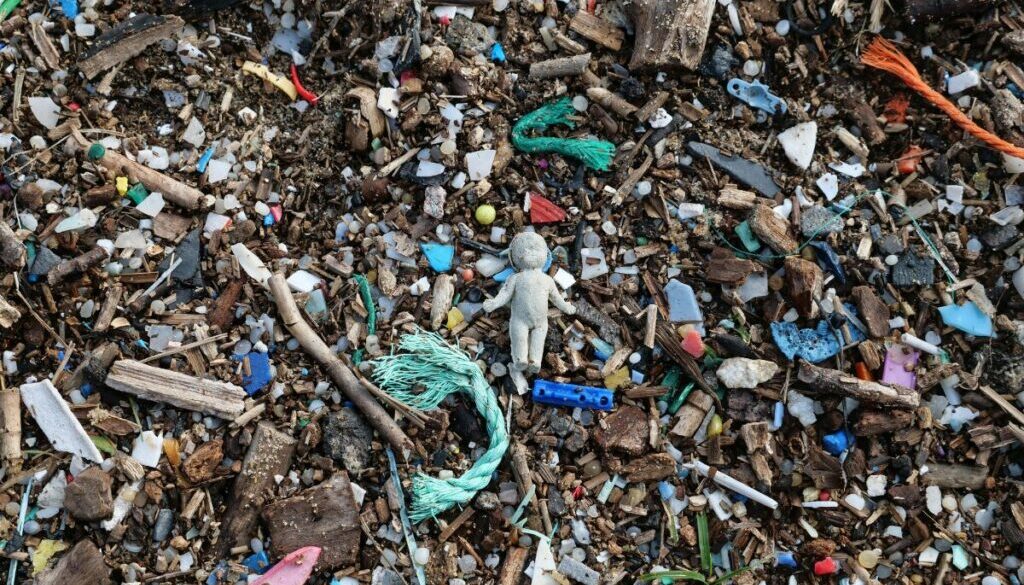Microplastics-Its What’s On The Menu
Picture by Sebastiem Vincon

Article By Helen Lovell-Wayne, MS
https://www.instagram.com/agreenerftr/
https://www.linkedin.com/in/helen-lovell-wayne/
hlovell@gmail.com
This article provides consumers with information about the products they may currently be buying and discarding, inadvertently contributing to environmental problems. Hopefully, with enough demand from consumers, industries will supply safer and more sustainable products.
Plastics are ubiquitous in Western societies, permeating nearly every aspect of daily life. Plastic has numerous advantages, such as being lightweight, flexible, and economical. Kitchens frequently contain a variety of plastic items such as: appliances, Tupperware, pot handles, bags, and containers for soaps, cereals, snacks, frozen food packaging, and dozens of other necessities. That is just the plastic found in one room. An immense 300 million tons of plastic pour into the global market annually (Disha Katyl et al. 2020).
Unfortunately, plastic tends to break down into tiny, long-lasting fragments (usually less than 5 millimeters in size) called microplastics ( Disha Katyl et al. 2020). Not surprisingly, microplastics are making their way into our bodies, which is causing numerous health problems. Mitigating microplastic exposure and contamination requires a multi-pronged effort involving individuals, communities, and policy changes to foster a more sustainable future.
💄The Creation Of Microplastics🛞
Microplastic originates from various plastic sources that we encounter every day including but not limited to food packaging, textiles, car tires, and hundreds of other sources. Disha Katyl et al. 2020). Additionally, the simple act of washing clothing can produce microfibers. Microfibers are a type of microplastic. Microfiber shedding occurs from textiles during wearing and laundering. Microfiber release is especially prevalent in synthetics such as nylon and polyester. One synthetic garment can release 1900 microfibers per wash into the wastewater (K. Blackburn and Green, D. 2022). For more information on sustainable laundry practices, see dirty laundry.
The other source of microplastics are those that are deliberately created. Following production, they are incorporated into cosmetics, abrasive blasting, and pharmaceuticals (Klaudia 2022). This is concerning because these microplastics are migrating into the ground and are attaching themselves to toxic compounds including but not limited to: pesticides, heavy metals, organic contaminants, (Klaudia 2022) fungicides, and pathogens (K. Blackburn and Green, D. 2022) and being ingested by plants or insects. These contaminated microplastics can then make their way up the food chain.
🐟 Microplastics In the Environment 🌾
The environmental hazards of microplastics extend beyond land, affecting both marine and freshwater systems. The projected doubling of microplastic pollution in some ocean areas by 2030 is cause for concern. (Robert Hale et al. 2020). The cold environment in the ocean keeps the microplastics from degrading further, hence they remain lingering in the ecosystem (Klaudia 2022).Microplastics have been found in the digestive systems of fish, mussels, oysters, birds, and marine mammals and also in the internal organs of fish ( J. Prata 2022 ).
Considering their prevalence, many people in Western society now have microplastics in their bodies. The most common method of entry is through ingestion. They are found in food, including but not limited to: seafood, salt, sugar, processed food, and honey (Kieran cox et al. 2019). Aluminum cans utilize a plastic-based lacquer or coating to serve as a barrier between the metal and the beverage, ensuring product integrity. This prevents the beverage from corroding the can (A. Chochol 2014). Consequently, microplastics can be found in all canned beverages. However, due to the chemical properties found in these two drinks, they are the most prevalent in both beer and soda (Diaz-Basantes, M., Conesa, J., and Fullana, A. 2020)
🧠Health Impacts of Microplastics🤕
These microplastics can potentially cause abrasive lesions and neurological conditions (recent studies have linked them to Alzheimer’s) (J. Prata 2022 ). Other toxins attach themselves to microplastics. These include pesticides and herbicides (for more information on sustainable alternatives to herbicides see war of the weeds) and can cause serious diseases including cancer ( J. Prata 2022 ).
Microplastics accumulate in the liver, kidneys and gut, depending on particle size. Biochemical biomarkers suggest that microplastic can cause problems with energy, metabolism, as well as oxidative stress (Kirsty Blackburn 2022). Oxidative stress can lead to cancer, cardiovascular disease, and neurodegenerative diseases. Microplastics can also accumulate in the brain tissue.
😓Reduction of Microplastics👝
Microplastics can be flushed out of the body via a natural elimination process. Surprisingly, microplastics can leave your body through sweat. (N. Fabiano, Brandon, L. and Puder, D. 2025) It would be beneficial if everyone exercised enough to build up a sweat at least three times a week. This purges some of the microplasitics in our bodies. Also, it could clear one’s mind of the microplastic predicament in which we are currently entangled. Mitigating large-scale microplastic pollution necessitates a multi-faceted strategy.
First and foremost, humanity must reduce its reliance on plastic. Financial incentives to use cloth shopping bags have worked in 12 states, and 500 cities across the United States. Additionally, consumers can buy fewer things wrapped in plastic. Going to farmers markets and other marketplaces with stands instead of brick and mortar stores which tend to use plastic packaging can help with this issue.
🌽Promising Microplastics Technology 🧪
If the demand for plastic decreases, then bioplastics could take the place of plastics. Bioplastics are plastics that are derived from renewable organic materials instead of petrochemicals. Consequently, they can be easily degraded with microbes and their enzymes. However bioplastics are more expensive to produce and harder to recycle than the alternative petroleum-based plastics (EB Arikan, et al. 2015).
The above tactics would assist in reducing microplastics created in the future. However, that still leaves the problem of reducing the microplastics that currently exist in the world’s ecosystems. At least in wastewater there appears to be a solution. Even with current technology, a significant amount of microplastics (2%) persists in tap water. However, there is a new technology that shows promise. Carbon nanomaterials is a new type of material that attracts and absorbs microplastics. (Ye Tang et al. 2021). This technology removes all microplastics in as little as 300 minutes. Addressing microplastic pollution effectively necessitates the invention of future technologies capable of extracting these particles from a range of ecosystems.
🧫Possible Solutions For Microplastics🗳️
Researchers are also exploring a marine bacterium that possesses the potential to degrade marine microplastics. These bacteria could then remediate contaminated environments. Harnessing microbes for the degradation of microplastics is a promising and apparently environmentally safe action plan. These microbes would enable the management of microplastics without apparent negative side effects, and eventually favor the natural cleaning of contaminated oceans (H. Auta, Emenike, C. and Fauziah 2017).
Microplastics are now found all over the world and they are affecting most life forms. They are causing disease and neurological disorders in people. The solutions must come from the public. Consumers need to make more informed decisions and vote for political candidates that protect the environment. People could consciously choose to consume fewer foods that contain microplastics until companies start using bioplastics. All wastewater treatment plants need to start using carbon nanometers.
🗳️ Less Microplastics In The Future 🛍️
If we all work together perhaps, we can stay on this planet a little longer. It is imperative to integrate and harmonize several measures (management, regulatory, technical and operational tools) at local, national, regional and international levels to address and tackle the problem ( O. Solomon1 and Palanisami, T. 2016). Microplastics are proof that bad things can come in small packages.
Text content




The Plastic Alchemist
December 1, 2025 @ 2:56 pm
[…] less plastic. For more information about reducing plastic waste, read Garbage Talk, 2025, and/or Microplastics-It’s What’s On The Menu. If you can’t avoid it is use plastic created from hemp, seaweed, coconut, and/or […]